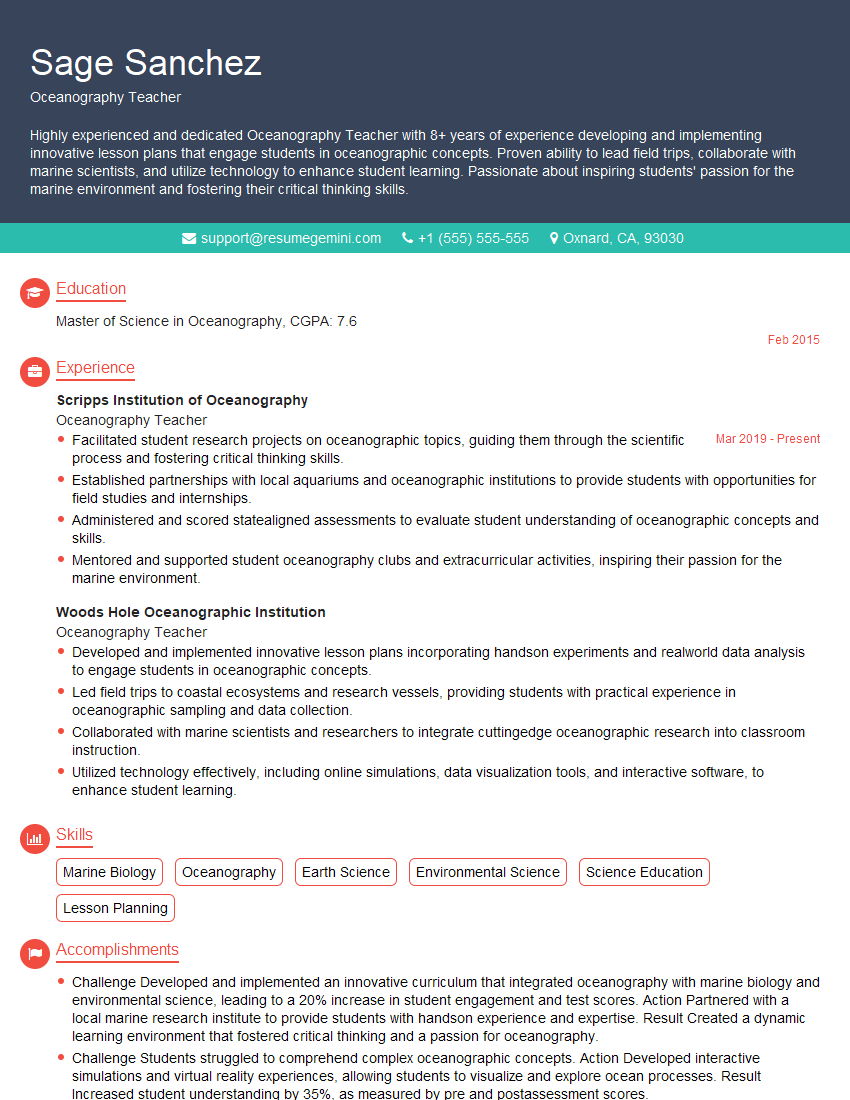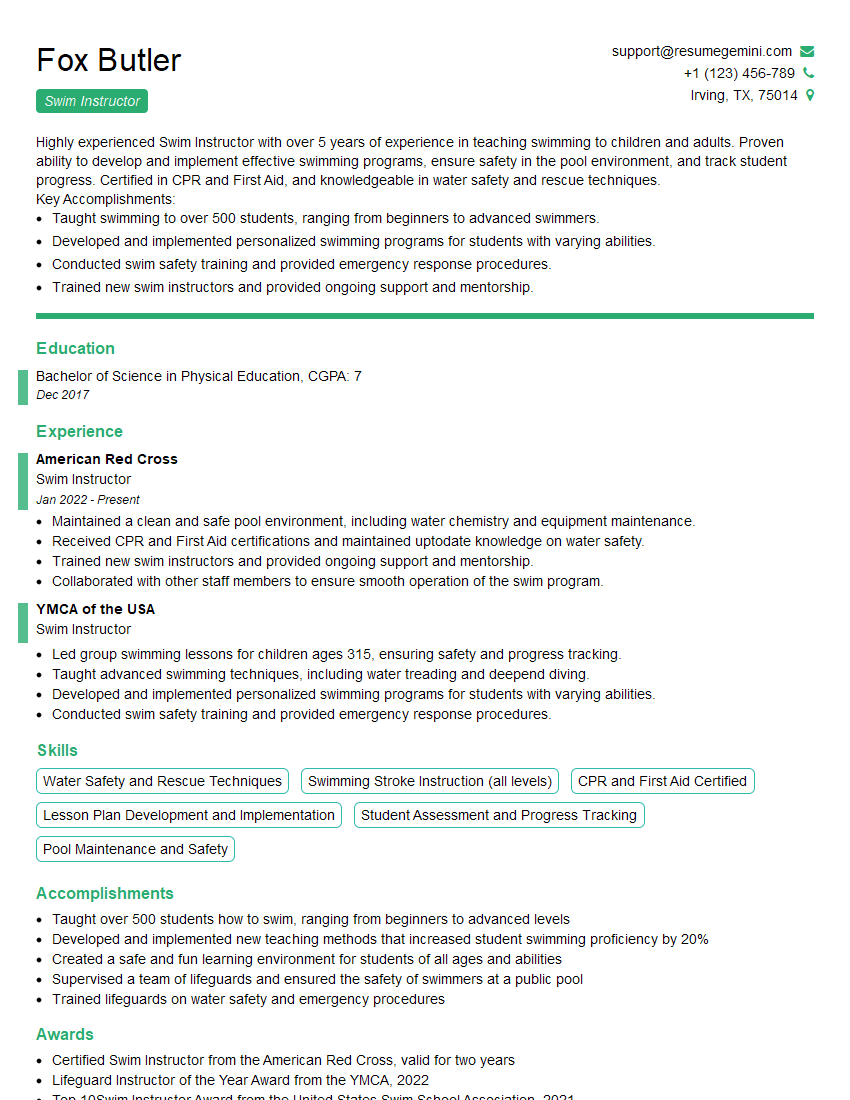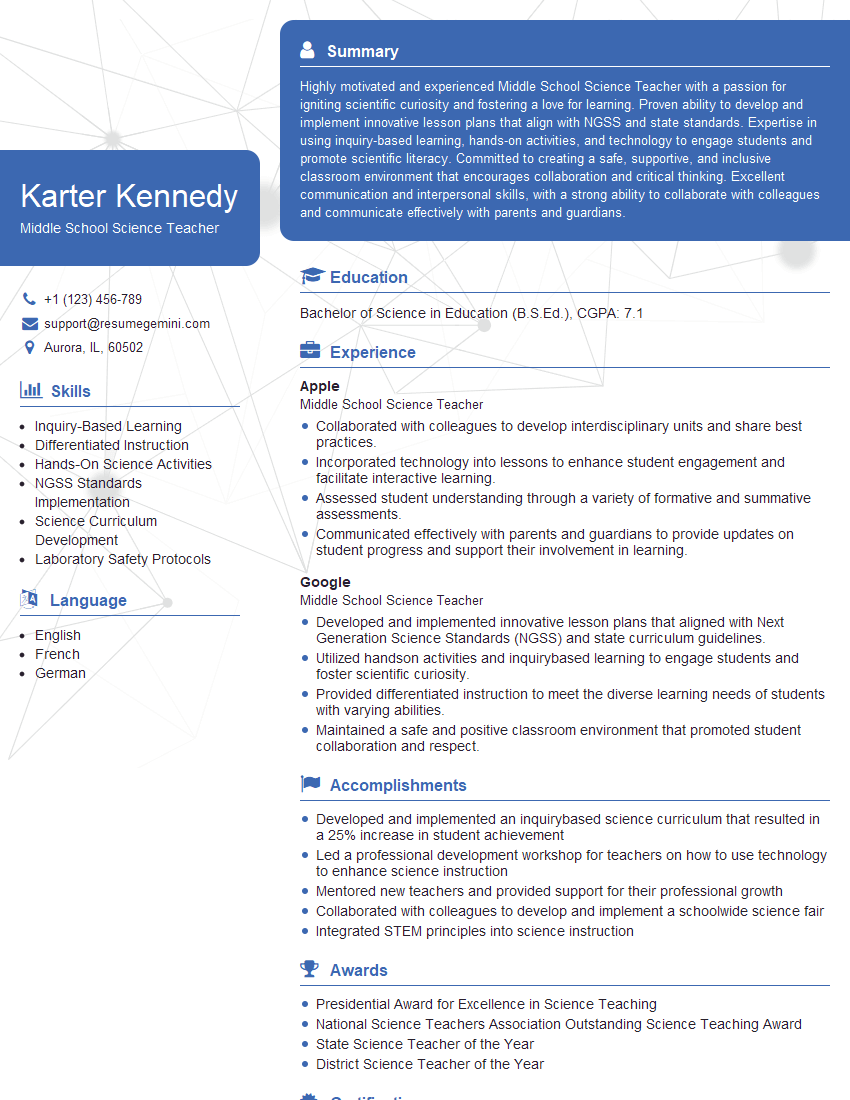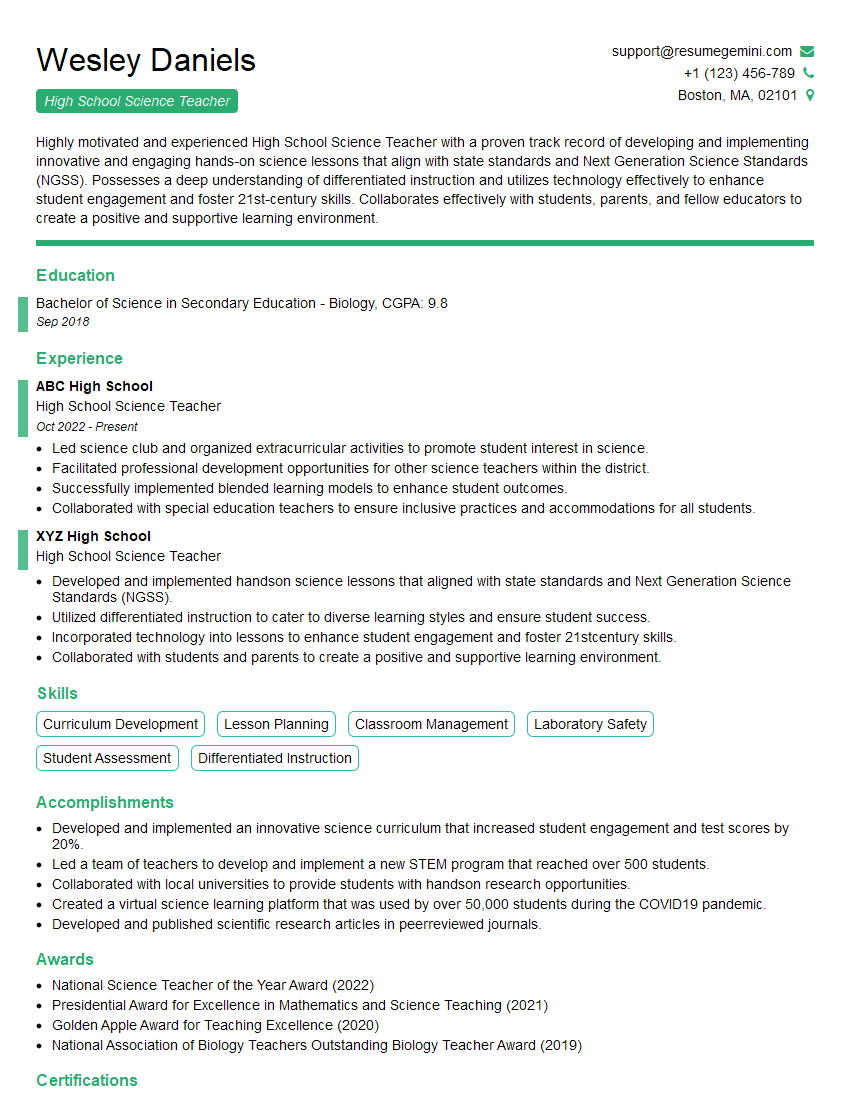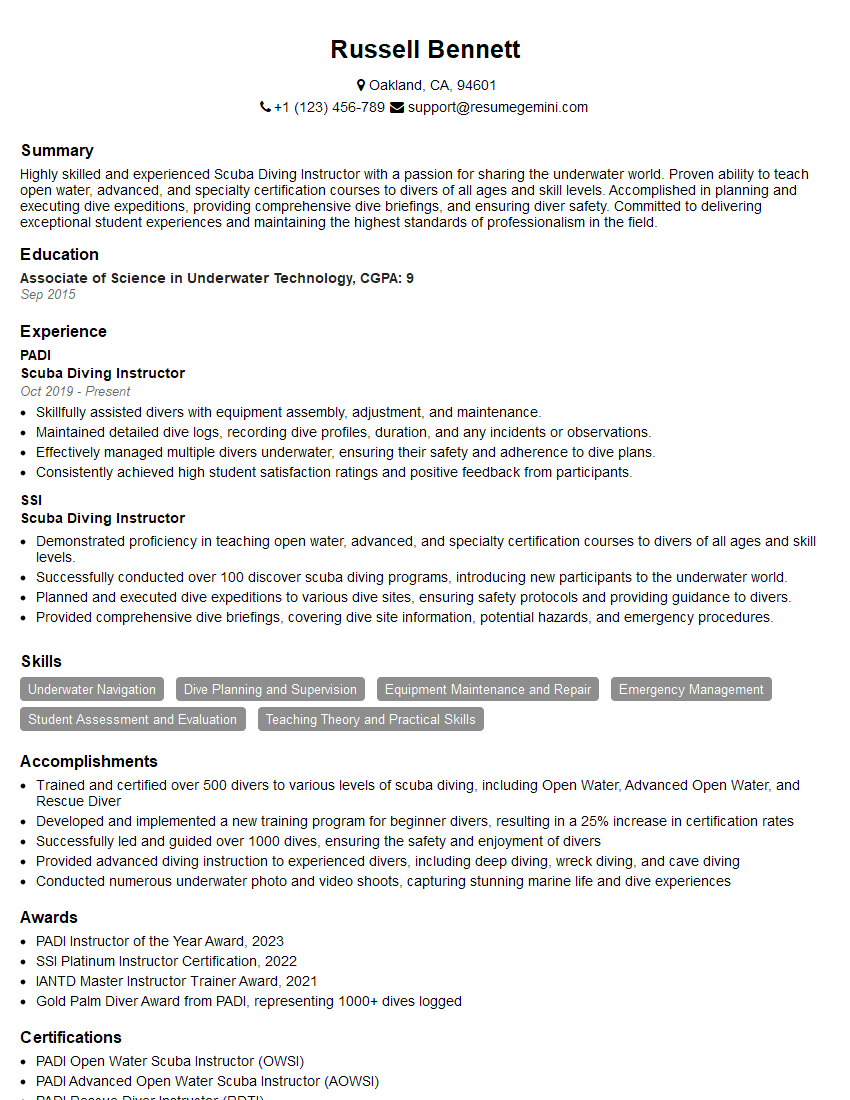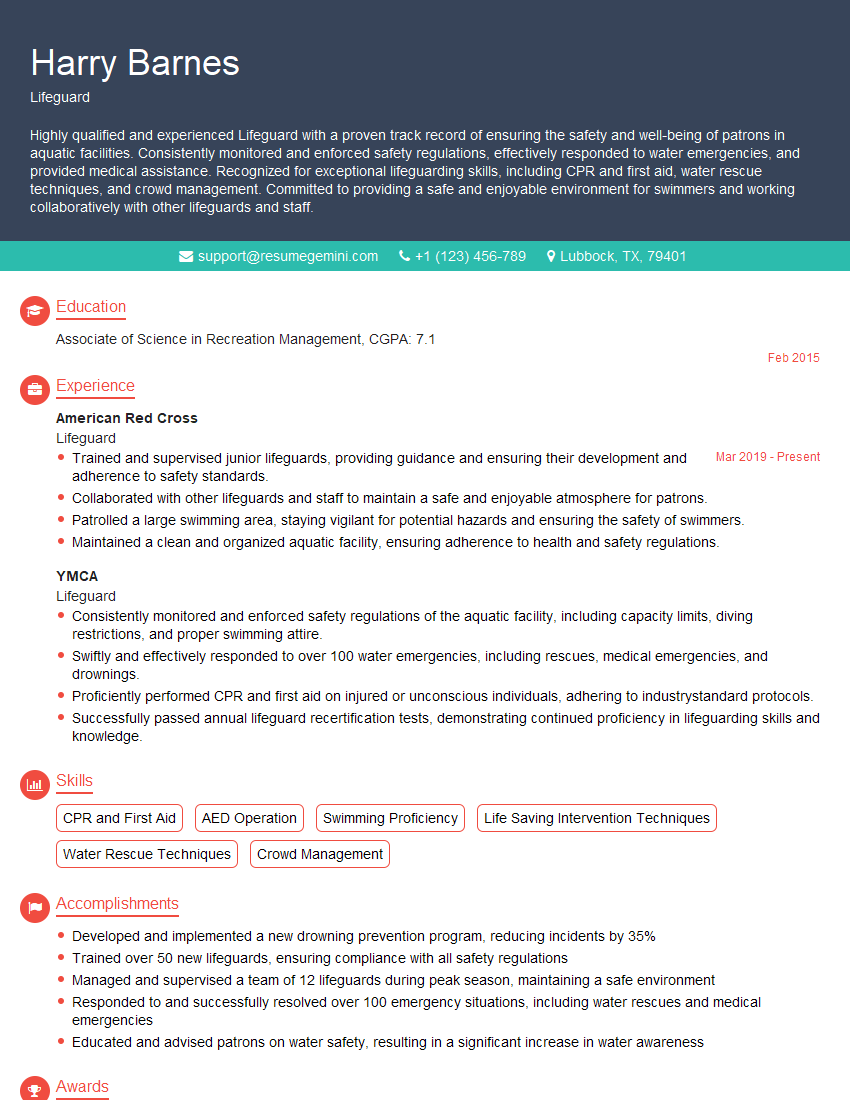The right preparation can turn an interview into an opportunity to showcase your expertise. This guide to Communicating Effectively with Students and Dive Teams interview questions is your ultimate resource, providing key insights and tips to help you ace your responses and stand out as a top candidate.
Questions Asked in Communicating Effectively with Students and Dive Teams Interview
Q 1. Describe your experience teaching complex diving techniques to diverse student groups.
Teaching complex diving techniques requires a multifaceted approach. I begin by assessing the students’ prior experience and skill levels, grouping them accordingly to tailor instruction. For example, beginners might start with buoyancy control and mask clearing, while more advanced students could focus on advanced navigation or wreck penetration techniques. I utilize a variety of teaching methods: demonstrations in a controlled environment (pool or confined water), detailed explanations with visual aids (diagrams, videos), and hands-on practice with constant feedback. I ensure that the learning environment is safe and supportive, fostering a culture of open communication where students feel comfortable asking questions and sharing concerns. I regularly incorporate scenarios to simulate real-life diving situations, improving problem-solving abilities and increasing confidence.
For instance, when teaching sidemount diving configuration, I would first demonstrate the proper tank placement and harness adjustment, then have students practice the setup step-by-step under my supervision. I would then move to a shallow water environment for controlled practice before progressing to deeper water dives. This staged approach caters to various learning styles and allows for individual attention. Additionally, I actively encourage peer-to-peer learning, where more confident students can help those who are struggling.
Q 2. How do you adapt your communication style for different learning styles in a classroom setting?
Adapting communication to different learning styles is crucial for effective teaching. I employ a variety of techniques to cater to visual, auditory, and kinesthetic learners. Visual learners benefit from diagrams, videos, and demonstrations. Auditory learners respond well to clear explanations, discussions, and concise instructions. Kinesthetic learners thrive with hands-on practice, simulations, and real-world application. I integrate all three styles into my lessons. For example, I might start with a clear verbal explanation of a technique, followed by a visual demonstration, and then conclude with supervised hands-on practice in the water. I also use varied questioning techniques to keep everyone engaged. Open-ended questions encourage deeper thought, while more direct questions help clarify understanding. Regularly checking for understanding using informal assessments (e.g., asking students to explain concepts in their own words) allows me to adjust my approach accordingly.
Q 3. Explain a time you had to handle a communication breakdown within a dive team. How did you resolve it?
During a deep wreck penetration dive, a communication breakdown occurred when my dive buddy’s primary communication device malfunctioned. He signaled that he was low on air, but the secondary communication system was also failing due to the depth and proximity to the wreck. Instead of panicking, I immediately signaled for an emergency ascent using standard hand signals. Once on the surface, we thoroughly assessed the situation. We discovered that the batteries in both devices needed replacement, a crucial oversight in pre-dive checks. I addressed the issue by reiterating the importance of pre-dive equipment checks, highlighting the need for redundancy in communication systems, and emphasizing the importance of clear hand signal proficiency. We reviewed appropriate emergency procedures, focusing on non-verbal communication methods, and practiced alternative signaling techniques in the shallows before our next dive.
Q 4. How would you address a student who is struggling to grasp a critical diving safety concept?
If a student struggles with a critical safety concept, such as proper buoyancy control or emergency ascent procedures, I take a patient, supportive approach. I would first identify the specific area of difficulty through questioning and observation. I would then simplify the concept using different analogies or examples that resonate with the student’s background or learning style. For instance, if they are struggling with buoyancy, I might use the analogy of a hot air balloon to explain how adjusting air in their buoyancy compensator (BCD) affects their position in the water. I might also break down the complex concept into smaller, more manageable chunks, focusing on one skill at a time. Hands-on practice with close supervision and frequent positive reinforcement is key. I would also encourage the student to practice outside of formal training sessions, providing them with supplementary materials or recommending additional resources.
Q 5. What methods do you use to maintain clear communication in a noisy or challenging underwater environment?
Maintaining clear communication underwater, especially in noisy or challenging environments, demands a multi-pronged approach. Primary reliance is placed on standardized hand signals, which are taught and practiced extensively. Backup communication systems, such as underwater slates or writing boards, are always used. I also emphasize the importance of brief, concise communication, avoiding unnecessary chatter. Before any dive, the dive plan is clearly communicated, and emergency procedures are reviewed. In situations with high ambient noise, we may resort to tapping or physically touching to convey urgency or attention. I continually assess the effectiveness of communication during the dive, adjusting my approach as needed. Regular communication checks ensure everyone understands the current status and potential risks.
Q 6. Describe your approach to providing constructive feedback to students after a dive.
Providing constructive feedback after a dive involves a balanced approach that combines positive reinforcement with specific, actionable suggestions for improvement. I start by highlighting the student’s strengths and accomplishments, boosting their confidence. Then, I offer specific and objective feedback on areas needing improvement. This feedback is always presented in a supportive and non-judgmental manner, focusing on the student’s performance rather than their personal qualities. I provide concrete examples of what the student did well and what could be improved. For instance, instead of saying “Your buoyancy control was bad,” I would say, “Your buoyancy control was inconsistent at times. During the ascent, you became slightly negatively buoyant which could be improved by adding a little more air to your BCD sooner.” I conclude by setting clear, achievable goals for future dives, and reiterate the importance of continued practice.
Q 7. How do you ensure your communication is both clear and concise when explaining emergency procedures?
Explaining emergency procedures demands absolute clarity and conciseness. I utilize a structured, step-by-step approach, employing simple language and avoiding technical jargon unless absolutely necessary. I ensure that all terminology is understood by everyone before the dive begins. Emergency procedures are practiced regularly, creating muscle memory and promoting automatic responses in stressful situations. Visual aids, like flowcharts or checklists, are used to reinforce the sequence of actions. I emphasize the importance of quick decision-making and decisive action. The procedures are explained in a calm and controlled manner to mitigate anxiety and improve retention. Regular drills and simulations in both controlled and unpredictable situations allow students to internalize these procedures and develop confidence in their ability to respond effectively.
Q 8. How do you handle a student who expresses anxiety or fear related to diving?
Addressing anxiety in diving students requires a compassionate and professional approach. It starts with active listening and validating their feelings. I begin by creating a safe space for open communication, assuring them that their concerns are normal and understandable. Many new divers feel apprehensive about the underwater environment. I then explain the safety procedures meticulously, emphasizing redundancy and backup systems. For example, I’ll show them the functionality of their BCD (Buoyancy Compensator Device) and how it helps them control buoyancy, alleviating fears of uncontrolled ascents or descents. I also incorporate gradual exposure; starting with shallow water dives in calm conditions before progressing to deeper or more challenging environments. Role-playing scenarios, such as equipment malfunctions, can help students build confidence in problem-solving skills and demonstrate their preparedness. Finally, I encourage them to communicate their feelings at any point during the dive, reiterating that safety is the top priority and that stopping a dive is always an option.
Q 9. How would you create a welcoming and inclusive learning environment for a diverse group of dive students?
Creating an inclusive learning environment for diverse students begins with acknowledging and respecting individual differences. I ensure that my communication style is adaptable, using clear and concise language, avoiding jargon, and adjusting my teaching style to cater to different learning preferences. This might involve incorporating visual aids for visual learners, hands-on activities for kinesthetic learners, or discussions for auditory learners. I actively promote teamwork and collaboration, encouraging students to support and learn from one another, regardless of their background or experience levels. I also make sure the physical accessibility of training locations and materials are considered, catering to any physical limitations or needs. For example, if a student has a visual impairment, I might provide larger print materials or use alternative methods to describe equipment and techniques. I actively challenge any biases and promote a culture of respect and mutual understanding. This is crucial for creating a positive learning atmosphere where all students feel safe, valued, and empowered to learn.
Q 10. What strategies do you employ to maintain a positive and safe learning environment during diving activities?
Maintaining a positive and safe diving environment is paramount. This starts with thorough pre-dive briefings that cover the dive plan, potential hazards, and emergency procedures. I emphasize the buddy system, ensuring each student is paired with a competent partner and understands their responsibilities. Regular checks on air pressure and other equipment are essential. Throughout the dive, I maintain constant visual contact and communication with each student, providing guidance and support as needed. We conduct thorough post-dive debriefings where students discuss their experiences, identify areas for improvement, and review safety protocols. This includes analyzing any near misses or incidents as learning opportunities rather than instances of failure. A crucial aspect is ensuring that all students understand and follow the safety guidelines strictly, including adhering to depth limits, maintaining proper buoyancy, and practicing safe ascent procedures. This requires consistent enforcement and clear communication of expectations.
Q 11. Explain how you use non-verbal cues to communicate effectively underwater.
Underwater communication relies heavily on non-verbal cues due to the limitations of verbal communication. Clear hand signals are essential, and I ensure that all students are thoroughly familiar with the standard dive signals before entering the water. For example, the ‘OK’ signal is critical, indicating that everything is alright. Other crucial signals include ascent and descent signals, out-of-air signals, and signals for problems with equipment. In addition to hand signals, I also utilize expressions and gestures to convey information. Maintaining eye contact is important, and body posture can indicate a diver’s level of comfort and confidence. For instance, a relaxed posture signifies calm, while clenched fists might indicate stress. I regularly practice and refine these non-verbal communication skills with my students, creating opportunities for them to practice these signals underwater in controlled environments.
Q 12. How do you ensure all members of a dive team understand the dive plan before entering the water?
Ensuring everyone understands the dive plan before entering the water is crucial for safety and efficiency. I conduct a comprehensive pre-dive briefing that includes a detailed overview of the dive site, the planned route, depth limits, bottom time, and potential hazards. I use visual aids such as maps, depth profiles, and photographs of the dive site to enhance understanding. I then engage the team in a question-and-answer session, ensuring everyone understands the plan fully. I emphasize the importance of each member communicating any concerns or questions. For instance, if a diver feels uncomfortable with a particular aspect of the plan, I address their concerns openly. I also explain emergency procedures and contingency plans in detail. This collaborative approach ensures everyone is on the same page and confident in proceeding with the dive.
Q 13. Describe your process for assessing a student’s readiness for advanced diving certifications.
Assessing a student’s readiness for advanced diving certifications is a multi-faceted process. It’s not solely based on completing a certain number of dives. I evaluate their buoyancy control, navigation skills, problem-solving abilities under pressure, and their understanding of advanced dive theory. I observe their performance in open water dives, paying close attention to their technique, decision-making, and adherence to safety protocols. I also assess their written and practical knowledge through examinations and in-water exercises that simulate challenging scenarios, such as equipment malfunctions or unexpected currents. Crucially, I assess their diving logbook to ensure they have sufficient experience and exposure to various diving conditions. If there are any areas for improvement, I provide targeted training and feedback to ensure the diver is fully prepared before advancing to the next certification level. Ultimately, it’s a holistic assessment of their skills, knowledge, and diving judgment.
Q 14. How do you use visual aids or technology to enhance understanding during diving instruction?
Visual aids and technology significantly enhance understanding during diving instruction. I use underwater video footage to showcase proper techniques and illustrate potential hazards. Interactive simulations on tablets or laptops can help students visualize different diving scenarios and practice problem-solving. Detailed dive site maps, 3D models of equipment, and presentations with high-quality images all improve comprehension. I incorporate online resources, such as interactive quizzes and online forums, to foster learning outside the classroom. For example, a 3D model of a regulator can help a student visualize the internal mechanisms and understand the airflow better. Technology also facilitates the sharing of dive plans and post-dive analysis, streamlining the learning process and improving communication among students and instructors.
Q 15. How do you adapt your communication for individuals with varying levels of diving experience?
Adapting communication to divers of varying experience levels is crucial for safety and effective training. I tailor my language and explanations based on their understanding of diving principles and terminology.
- Beginner Divers: I use simple, clear language, avoiding jargon. I focus on fundamental concepts, using analogies and visual aids to reinforce learning. For example, explaining buoyancy control using the analogy of a hot air balloon.
- Intermediate Divers: With intermediate divers, I can introduce more complex concepts and technical terminology, while still ensuring understanding. I’ll encourage questions and discussions to assess their comprehension.
- Advanced Divers: Communication with advanced divers can be more technical and nuanced. I expect a higher level of understanding and can engage in problem-solving discussions related to advanced techniques and challenging dive scenarios.
This tiered approach ensures everyone receives the information they need at a pace and level they can comprehend, maximizing safety and learning.
Career Expert Tips:
- Ace those interviews! Prepare effectively by reviewing the Top 50 Most Common Interview Questions on ResumeGemini.
- Navigate your job search with confidence! Explore a wide range of Career Tips on ResumeGemini. Learn about common challenges and recommendations to overcome them.
- Craft the perfect resume! Master the Art of Resume Writing with ResumeGemini’s guide. Showcase your unique qualifications and achievements effectively.
- Don’t miss out on holiday savings! Build your dream resume with ResumeGemini’s ATS optimized templates.
Q 16. Describe a situation where you had to communicate a complex piece of information quickly and efficiently to a dive team.
During a night dive, we encountered unexpectedly strong currents. I needed to quickly relay instructions to my team, who were already slightly disoriented due to the reduced visibility. I used concise, clear commands delivered calmly but firmly. I avoided technical jargon, focusing on immediate action. My instructions focused on:
- Maintaining buddy contact.
- Ascending slowly to a shallower depth.
- Following a specific navigation technique to reach the designated ascent point.
I used hand signals as visual reinforcement, ensuring everyone understood the message before executing the commands. This rapid, efficient communication ensured the team’s safety during a potentially hazardous situation.
Q 17. How do you build rapport and trust with students or team members?
Building rapport and trust is paramount in both diving and teaching. It starts with demonstrating genuine respect and care for individuals’ safety and well-being.
- Active Listening: I pay close attention to what students and team members say, both verbally and nonverbally.
- Empathy and Understanding: I recognize that individuals learn and react differently. I try to understand their perspectives and concerns.
- Open Communication: I encourage open dialogue, making it safe for individuals to express their concerns or uncertainties.
- Positive Reinforcement: Recognizing and celebrating successes, big or small, builds confidence and encourages further learning.
- Leading by Example: Demonstrating competence, responsibility and calmness instills confidence in others.
By fostering a safe and supportive environment, I can build strong, trusting relationships with students and team members.
Q 18. How would you explain the concept of buoyancy control to a beginner diver?
Buoyancy control is the ability to maintain a neutral position in the water, neither sinking nor floating. Think of it like a hot air balloon; you need to adjust the amount of air to stay at a desired height.
In diving, we adjust our buoyancy by controlling the amount of air in our buoyancy compensator device (BCD). By adding or removing air, we can subtly adjust our position in the water. If you feel you’re sinking, you add air; if you’re rising, you release some. We also use proper breathing techniques and weight adjustment to fine-tune our buoyancy, ensuring comfortable and safe diving.
Q 19. Describe your experience managing conflict within a dive team.
I once had a disagreement within a dive team about the best approach to a particular dive site. One member wanted a more challenging route, while others preferred a safer, less demanding option. I addressed the situation by:
- Facilitating open discussion: I created a space where each member could express their concerns and perspectives without interruption.
- Identifying shared goals: I reminded the team that our primary goal was safe and successful completion of the dive.
- Finding a compromise: We agreed on a route that incorporated elements of both suggestions, ensuring safety and some element of challenge.
By mediating the conflict constructively, I ensured team cohesion and a successful dive.
Q 20. How do you address safety concerns raised by a student or dive team member?
Safety concerns raised by a student or team member are never taken lightly. I address them with the utmost seriousness and prioritize the safety of everyone involved. My approach involves:
- Active Listening: I listen carefully to the concern, asking clarifying questions to fully understand the issue.
- Assessment and Investigation: I investigate the concern thoroughly, considering all relevant factors.
- Open Communication: I clearly explain my assessment and the actions being taken to address the concern.
- Decision Making: If the concern warrants it, I make the decision to alter the dive plan, postpone the dive, or take other appropriate action.
- Documentation: I thoroughly document all safety concerns, assessments and actions taken.
Addressing safety concerns promptly and effectively is essential for a safe and positive diving experience.
Q 21. What are some strategies for preventing communication errors during underwater operations?
Preventing communication errors during underwater operations requires a multi-faceted approach:
- Pre-Dive Briefing: A thorough pre-dive briefing outlining the dive plan, potential hazards, and communication protocols is essential.
- Redundant Communication: Using multiple communication methods (e.g., hand signals, slates, and underwater communication devices where appropriate) reduces reliance on a single method.
- Regular Checks: Frequent buddy checks to confirm understanding and address any issues proactively.
- Clear and Concise Signals: Using standardized and universally understood hand signals and written communication.
- Emergency Procedures: Establishing clear emergency protocols and practicing them regularly ensures everyone understands how to respond in critical situations.
- Environmental Awareness: Being mindful of conditions that can affect communication, such as strong currents or reduced visibility.
By prioritizing clear communication and redundancy, we significantly mitigate the risk of errors during underwater operations.
Q 22. How do you deal with situations where your directions are misunderstood by a dive team member?
Misunderstandings happen, even with the best planning. My first step is to acknowledge the error without placing blame. I’d ask open-ended questions like, “Can you explain what you understood from my instructions?” to understand the source of the confusion. Then, I’d re-explain the instructions, using different wording or visual aids if necessary. For example, if I instructed a diver to ‘inspect the starboard engine mount,’ and they inspected the port side, I’d clarify, perhaps by pointing directly to a diagram of the engine, and rephrase: ‘Please check the engine mount on the right-hand side of the vessel.’ Finally, I confirm understanding by asking the diver to repeat the instructions back to me in their own words. This ensures we’re on the same page before proceeding.
Q 23. Describe your preferred method for delivering safety briefings before a dive.
My preferred method for safety briefings involves a combination of verbal explanation, visual aids, and interactive elements. I start with a clear overview of the dive plan, including the objective, location, depth, anticipated conditions, and expected duration. I then highlight key safety considerations, including emergency procedures (e.g., ascent rates, buddy checks, emergency ascent signals). I use diagrams, charts, and even photos of the dive site to illustrate key points. Crucially, I make the briefing interactive; I encourage questions and invite team members to share any concerns they may have. This ensures everyone is informed, engaged, and confident in their understanding of the plan before we enter the water. This fosters a strong team environment where all members feel comfortable voicing their thoughts and concerns.
Q 24. Explain how you adapt your communication when facing communication challenges such as language barriers.
Language barriers necessitate a multi-faceted approach. I rely heavily on visual aids – diagrams, charts, and hand signals – to convey information beyond words. If possible, I utilize translation apps or enlist a translator. Simple, clear language, avoiding jargon, is paramount. I break down complex instructions into smaller, manageable steps. I also use a lot of nonverbal communication – pointing, demonstrating, and using facial expressions to support my instructions. For example, during a dive where a team member speaks only Spanish, I might rely on simple pictures demonstrating ascent procedures and point to the pressure gauge to show the need to keep monitoring it. I always confirm understanding through demonstrations or asking them to show me they understand using the same visual cues. This combines practical learning with visual affirmation.
Q 25. What tools and techniques do you use to maintain communication if there’s equipment malfunction in a dive?
Maintaining communication with equipment malfunction is critical. I employ a layered approach. First, we have backup communication devices: redundant underwater communication systems (such as dive computers with built-in communication). If those fail, we revert to established hand signals, agreed upon beforehand and practiced regularly. Visual cues, such as pointing towards the ascent line or a designated emergency marker buoy, become essential. For surface-to-diver communication, I would rely on methods such as surface markers with clearly visible flags or signals. Each team member has undergone training on these backup methods so that everyone is familiar with them. The key is preparedness and having multiple communication strategies to fall back on.
Q 26. How do you conduct post-dive debriefs to identify areas for improvement in communication and safety?
Post-dive debriefs are crucial for continuous improvement. I conduct these in a safe, relaxed environment, encouraging open feedback. We review the dive plan, noting any deviations or challenges encountered. The team discusses areas of effective communication and identifies instances where communication could have been improved. We analyze any near-misses or actual incidents to understand their root causes. This includes assessing the clarity of instructions, the effectiveness of safety measures, and the responsiveness of the team members to each other. The goal isn’t to find fault but to identify what went well and what could be improved for future dives – improving team cohesiveness and safety protocol. We document key points to review in future briefings.
Q 27. Explain your understanding of the importance of clear and concise communication in preventing diving accidents.
Clear and concise communication is paramount in preventing diving accidents. Ambiguity can lead to misinterpretations of instructions, potentially resulting in unsafe practices. For example, unclear instructions on decompression stops could lead to a serious case of DCS (Decompression Sickness). A simple miscommunication about equipment usage could lead to equipment failure. By ensuring clear, concise instructions, using appropriate terminology, and confirming understanding at every stage, we significantly reduce the risk of human error. It’s the foundation of safe diving operations. Regular training and practice of communication protocols and emergency procedures are also essential in creating a strong safety culture.
Q 28. Describe your experience in using different communication devices for underwater communication.
My experience includes using various underwater communication devices, such as underwater communication systems which use acoustic signals for communication between divers and surface. I have also worked with dive computers equipped with communication functionality, allowing for diver-to-diver communication. These devices require regular testing to ensure functionality, which is a standard practice we rigorously follow. The reliability and range of different communication systems is always an element we carefully consider in our dive planning. We’ve also experimented and trained using hand signals for close-quarters communication to add redundancy to our overall communication plan. Experience with these different systems has taught me the importance of redundancy and fallback systems in maintaining communication in challenging underwater environments.
Key Topics to Learn for Communicating Effectively with Students and Dive Teams Interview
- Active Listening and Feedback Techniques: Understanding nonverbal cues, adapting communication styles to diverse learners/divers, providing constructive criticism and positive reinforcement.
- Clear and Concise Instruction Delivery: Developing and presenting information in a way that is easily understood by varying skill levels and experience backgrounds, considering different learning styles (visual, auditory, kinesthetic).
- Managing Diverse Groups and Conflict Resolution: Facilitating group discussions, addressing disagreements effectively, promoting collaboration and teamwork in both classroom and underwater environments. Strategies for mediating differing opinions and maintaining safety.
- Risk Assessment and Safety Communication: Communicating potential hazards clearly and concisely, emphasizing safety protocols, ensuring everyone understands procedures and emergency response plans. This includes understanding and addressing potential communication barriers in high-pressure situations.
- Nonverbal Communication in Challenging Environments: The importance of clear signals, visual aids, and alternative communication methods in situations with limited visibility or noisy environments. Understanding the impact of body language and adapting communication accordingly.
- Technology and Communication Aids: Utilizing technology effectively to enhance communication (e.g., underwater communication systems, presentation software, online learning platforms) and troubleshooting technical difficulties.
- Building Rapport and Trust: Establishing positive relationships with students and dive team members, creating a supportive and inclusive learning environment, demonstrating empathy and understanding.
Next Steps
Mastering effective communication with students and dive teams is crucial for career advancement in education, marine science, and related fields. Strong communication skills are highly sought after, demonstrating your ability to build relationships, lead teams, and ensure safety in demanding environments. To increase your job prospects, focus on building an ATS-friendly resume that highlights your relevant skills and experience. ResumeGemini is a trusted resource that can help you create a professional and impactful resume. Examples of resumes tailored to Communicating Effectively with Students and Dive Teams are provided to guide you in this process.
Explore more articles
Users Rating of Our Blogs
Share Your Experience
We value your feedback! Please rate our content and share your thoughts (optional).
What Readers Say About Our Blog
There are no reviews yet. Be the first one to write one.
